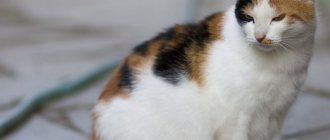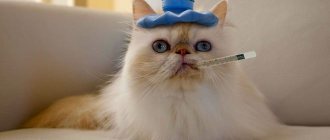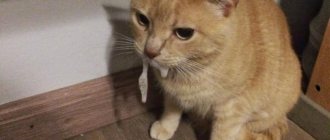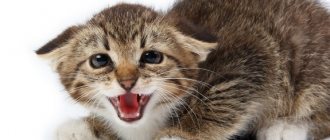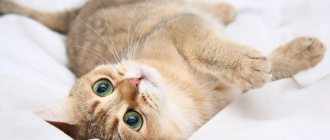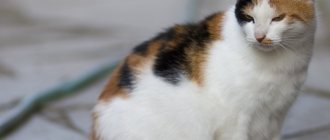The normal state of a cat's pupils
Cats are predators, their eyes have a thin vertical stripe.
Cats, like many predators, have vertical pupils. Cats need this shape of pupils in order to assess the distance to the object of hunting and during a jump, attack on the sly.
The retina of a cat’s eye is very sensitive to light, and this is the answer to why cats’ pupils narrow in the light and dilate as much as possible in the dark. In the dark, dilated pupils allow more light to pass through and thus see even at night. And so that the bright light from the sun does not harm the cat’s vision, when light or a ray of sun hits the animal’s eyes, the pupil narrows as much as possible to a vertical strip.
The normal state of a cat's pupils is constricted, which reacts by dilation and contraction to light or external stimuli.
Tips for cleaning your cat's eyes
Although we have seen that the reasons why a cat has dilated pupils a lot and does not necessarily mean a lack of cleanliness, it is always advisable to maintain good hygiene in this part of the body to avoid irritation or problems caused by dirt. Here are some tips:
If the cat produces many legions, they should be removed every morning with sterile gauze and physiological serum or chamomile in its absence. It is good to fix the cleaning routine of the most delicate areas such as the eyes and ears. For adopted cats this is also important, always little by little and through positive reinforcement. If the hair around the eyes is too long, it needs to be trimmed to prevent it from getting into the eyes and causing damage. If your cat develops ocular discharge, inflammation, redness, or excessive itching, it should be taken to a veterinarian as soon as possible.
This article is for informational purposes only, we are not in a position to prescribe veterinary procedures or make any diagnoses. We invite you to take your pet to the veterinarian in case of any conditions or discomfort.
When dilated pupils in a cat are a sign of normality
Cats' pupils dilate naturally when reacting to light, fear or interest.
Dilation and constriction of a cat's pupils, which occur temporarily at the time of reaction, are considered normal.
Most often, dilated pupils in an animal can be observed during estrus. The hormones produced by the cat during this time often cause her pupils to dilate. They symbolize the female's desire and desire to find a male to mate with. This is the natural state of the animal and there is absolutely nothing to be afraid of.
Also, the pupils can dilate in response to light: the darker it is, the larger the cat’s pupils.
Including as a reaction to an external stimulus: to a sharp sound, to sudden stress. A cat dilates its pupils when it gets scared. This means she is ready to attack.
The reason could be a new pet in the house, a stranger, moving to a new place unfamiliar to the cat.
A cat's pupils dilate during games, fights, and while bathing.
In such cases, there is no need to fear for the animal’s health, and dilated pupils under these circumstances are the norm and a natural reaction of the pet.
Main reasons
Stress and nerves
A common reason that causes wide pupils.
If the animal senses something is wrong or becomes very frightened, visual functions become more acute. This helps to notice danger in a timely manner and respond to it immediately. Unfamiliar surroundings, strangers and objects in the house also make the animal worried and wary. There is a breed of cat, for example, the Singaporean, which has a highly developed maternal instinct. The mother cat constantly protects and protects the kitten, and if the baby is suddenly separated and given to other owners, the animal will begin to worry a lot and cannot find a place for itself. Due to stress, the pupils immediately dilate, the cat becomes wary, and may stop trusting the owner and hide the rest of the kittens.
Pathological causes of dilated pupils
Dilated pupils in a cat are not always normal
Large dilated pupils in cats for a long time, without any particular reason, may be a signal that the animal has a disease.
What you need to pay attention to:
- Based on the age of the animal. As a cat ages, it may develop loss of retinal sensitivity;
- For head injuries. With a concussion, the cat could have damaged blood vessels, which caused the pupil to dilate. As a rule, this goes away within a couple of hours, if it does not go away, you should consult a doctor;
- Dilated pupils are accompanied by decreased activity, unusual postures for the animal, and impaired coordination of movements. This may be caused by a brain tumor. The cat needs to be examined at a veterinary clinic;
- Cloudy corneas, along with dilated pupils, can develop due to injury or internal infections.
Ophthalmological problems
This is what the eyes of an animal with retinal disease look like
Dilated pupils in a cat for a long time can result in eye diseases, such as:
- Cataracts usually affect older cats. The disease manifests itself as clouding of the cornea with a bluish tint.
- Retinal atrophy. The disease is inherited and mainly in purebred cats. May cause blindness.
- Blepharitis is inflammation of the eyelids.
- Conjunctivitis is expressed in the appearance of mucous and purulent discharge from the eyes. It can be either infectious or allergic, and can also develop due to a foreign object entering the animal’s eye.
Treatment of these diseases is prescribed by a veterinarian.
Conjunctivitis may go away on its own, but it is advisable to rinse your eyes with tea leaves or Miramistin.
Reaction to pain and possible diseases
Persistent dilated pupils and cats may be due to pain
When a cat is in pain, she almost never shows it. These animals are very patient. Dilated pupils may indicate that the animal is in pain. Carefully monitor the animal's behavior; it may have injured itself or sprained its paw. Then, in addition to dilated pupils, she will lick the injured area and move strangely.
But the pain can be internal and associated with various diseases:
- a brain tumor;
- heart disease, kidney disease, stomach disease;
- stroke;
- internal bleeding;
- poisoning or infections
In such cases, delay is dangerous, since the owner’s timely response is very important for the life and health of the pet.
State of stress
The cat may be chronically stressed or fearful
A cat's pupils may dilate during sudden stress or fright caused by a loud noise, a vacuum cleaner, a hair dryer, or as a reaction to a new pet or person. The animal's tail fluffs up, its ears press against its head, and it may hiss. But when the irritant disappears, the cat will calm down and return to its normal state.
But stress can also be permanent. It is expressed in increased blood pressure and rapid breathing. In this state, the animal’s immunity is weakened and digestion slows down. Stress can be a factor in the development of various diseases.
What can cause stress
Many factors can cause fear in an animal; it is advisable to avoid them
- late socialization. The cat may be afraid of both the owner and other people living with him;
- poor nutrition;
- violence by people or other animals;
- taking medications, injections during treatment - cats don’t like this;
- going to the vet;
- moving;
- water procedures.
During prolonged stress, cats' appetite worsens, they hide, react with aggression, and lose their playful mood. The general behavior of the cat changes, it becomes uncommunicative, isolates itself, licks its fur nervously, itches frequently, may urinate past the litter box, reacts to every sound with sudden movements, jumping, and fluffs its tail.
To calm the animal, you need to exclude its contact with the object of stress, feed it something tasty, pet the animal more, speak in a calm voice, and do not shout.
Symptoms, behavior changes
- Changes in breathing (shallow breathing, rapid and/or noisy breathing).
- The desire to lie down, or a reclining position, the mouth is half open, the animal is breathing frequently and with “strain.”
- Lethargy or apathetic state.
- The desire to hide in the farthest corner.
- Cough (in some cases).
- Bluish or burgundy-red gums.
In mild cases, such clinical signs practically do not occur. For example, if the pathology appears after anesthesia, then, as a rule, there is nothing wrong with it. Difficulty, hoarse and rapid breathing, which is accompanied by the release of reddish foam and/or mucus from the nasal passages, is the first sign of serious pathologies of the pulmonary circulation. Simply put, there is definitely something wrong with your pet's heart or lungs.
For example, hydrothorax, when a kind of pond appears in the chest. May occur due to feline infectious peritonitis (FIP) as well as congestive heart failure. In principle, rapid breathing in an elderly cat is almost certainly associated with chronic heart failure, which in itself can easily cause shortness of breath.
Please note that in cats of brachycephalic breeds (Persians) with a flattened muzzle, shortness of breath is a constant phenomenon. Of course, it is difficult to call it “physiological”, since it develops due to the abnormal structure of the cranial cavities. But still nothing can be done about it. But if your cat has rapid breathing and heart rate, something is clearly wrong with her.
Cats often suffer from eye problems. Some diseases are not dangerous, but some of them can cause complete loss of vision. One of the main signs of a problem is a cloudy cat's eye.
If a cat's eye is cloudy, then at first glance he appears to be blind. However, this is not always the case. There is only one sign of cloudy eyes in an animal – a white veil.
A cat's eye can become cloudy for a variety of reasons.
But over time, other symptoms may appear, for example:
- Blepharospasm and photophobia.
- Swelling of the conjunctiva.
- Irritability.
- Protrusion of the eye from the socket.
- Enlargement of the eyeball.
- Dilatation of blood vessels in the eye.
- The presence of purulent or mucous discharge from the eyes.
- Sleep disturbance.
- Loss of appetite.
We suggest you read: Baldness in cats, causes, treatment.
You should not wait for signs of complications to appear, and if you notice clouding of the eye, you should immediately contact a veterinarian.
The most common causes of cloudy eyes are glaucoma, cataracts or keratitis. These problems are increasingly being identified in cats of different breeds and ages.
Glaucoma
When a cat has glaucoma, the intraocular pressure increases, the size of the eyes changes, and vision begins to disappear.
The cat owner may also notice the following changes:
- the pupil is dilated;
- the cornea is almost white;
- coordination is impaired.
But the cat mostly bumps into surrounding objects only because it doesn’t see well. Moreover, the disease can affect both eyes at once. The cause of glaucoma, which can be congenital or acute, can be a severe form of keratitis or lens luxation.
Cataract
A cataract is a clouding of the eye that begins at the pupil. The lens may completely lose its transparency. The disease can be caused by an inflammatory disease of the eye, trauma, or a previous infection. Most often, this problem occurs in older cats due to metabolic disorders.
Cloudiness of the eye can occur due to cataracts.
In this case, clouding of the surface of the eye is observed. It can begin to grow from any area of the eye, resembling the gradual stretching of a dense film. Keratitis in cats occurs due to an inflammatory process in the tissues of the cornea, or due to an infection in the eye. It is not uncommon for the eye to become cloudy after an injury. In any form, keratitis is a serious problem.
Keratitis is also a consequence of age-related disorders, untreated conjunctivitis, and the formation of ulcers on the corneas.
In addition to the above reasons, there are other “culprits” for the development of cloudy eyes:
- Damage to the tear duct.
- Poor care after removal of the third eyelid.
- Bacterial infection.
- Cancer disease.
- Pathologies of the vitreous body.
- Autoimmune diseases.
What to do if a cat's eye becomes cloudy, the doctor can tell you only after a complete examination of the pet. He will examine the cornea, eyelids, lens and determine the condition of the vitreous body.
For eye problems, the veterinarian does tonometry.
- Schirmer's test. It is carried out using special paper, which is placed in the corner of the eye and the intensity of its wetting is observed. This is necessary in order to understand whether the animal produces enough tear fluid.
- Use of UV lamps. This method allows you to determine the presence of erosions and ulcers on the cornea. To do this, a special composition is applied to the cornea, which, if there are problems with the surface being examined, begins to fluoresce.
- Tonometry. By measuring the pressure in the eyeball, you can identify not only existing glaucoma, but also its first signs.
- Serological and complete blood tests are necessary to identify an infectious disease.
- Studies to determine feline immunodeficiency virus, leukemia, infectious peritonitis, toxoplasmosis.
If there is insufficient information to make an accurate diagnosis, other research methods are used:
- Corneal cytology (scraping).
- Tests for sensitivity to a number of drugs. If the doctor previously found out that vision was impaired due to exposure to fungi, bacteria or viruses, then he must conduct tests using certain drugs, most often antibiotics. This is necessary in order to understand which medications will be most effective in treatment.
- Determining the presence of herpes, which is often the cause of eye problems.
- Paracentesis is a test of the vitreous body.
- Serology.
- Electroretinography.
- Ultrasound examination of the eyes. This method is used when the surface of the eyeball is very “clouded.”
Treatment methods
Many cat breeders are wondering how to treat their pet at home. The answer to this question depends on what kind of disease is detected in the animal. In some cases, treatment may be required in a veterinary clinic.
If the cause of clouding of the eye is an infectious disease, then the animal will be prescribed treatment with broad-spectrum antibiotics or antibacterial drugs in fairly large doses.
In the presence of corneal ulcers or glaucoma, surgery is used. The main difficulty in this case is the severity of the therapy; often, with glaucoma, the risk is complete removal of the eye.
Treatment depends on why your cat's eye is cloudy.
Non-steroidal anti-inflammatory drugs are also used in the treatment of cloudy eyes. Their use also has a number of contraindications, since these drugs, when used for a long time, negatively affect the general condition of the animal’s body.
In almost all cases, no matter what disease is detected in a cat, it is prescribed to instill antiseptic drops into the conjunctival cavity and apply medicinal ointments. They are needed to moisturize the affected organ, because the liquid is a barrier to the entry and development of pathogenic microflora.
In addition to medications, you need to remember that the cat needs to create a comfortable environment during the treatment period. The animal requires rest and a special diet containing vitamins E and A. These supplements will help restore the affected areas of the cornea.
In some cases, complex treatment is prescribed, which consists of:
- use of tetracycline ointment or gamavit;
- washing with metrogil solution;
- use of drugs based on Actovegin;
- therapy with antiviral drugs.
Eye drops and ointments are used for treatment.
Even the most complex eye diseases that lead to clouding can be prevented or delayed. To do this, you just need to carefully monitor your pet.
We suggest you read: How to remove mats from cats
Monitor your cat's eyes at least twice a day. If you notice redness, discharge from the eyes, blurred vision or pain, contact a specialist immediately.
All of the above symptoms may indicate the development or worsening of the pathological process.
If your cat suffers from an eye condition and has difficulty seeing, ensure her complete safety. To do this, remove from the room objects that may be dangerous for the animal - chairs, tables and other obstacles.
Cats often injure themselves. A surgical collar will help you avoid self-injury to your eyes. It is placed around the pet’s neck, and the cat is no longer able to reach its eyes with its paws and rub them.
In order for your cat to be treated effectively, you need to remember that all medications prescribed by your veterinarian must be used strictly according to the instructions. You do not need to prescribe medications for your pet yourself, increase or decrease the recommended dosage, or change the medication schedule.
Veterinary medications must be used to treat cat eyes.
You should not resort to folk remedies that suggest pouring powdered sugar into the cat’s eye or dropping milk. All this, at best, can lead to a blurred clinical picture, and the doctor will not be able to timely identify the true problem. In the worst case scenario, the animal will permanently lose its vision.
Even the most serious disease can be overcome if you consult a specialist in a timely manner and do not self-medicate, wasting time.
Sometimes, during difficulty breathing, the pet may experience pain. Externally, this manifests itself as the following signs:
- the cat looks excited and scared;
- the muzzle is stretched out in an unusual grimace;
- pupils dilated;
- the tail is pressed to the body;
- mustache pressed;
- the animal is aggressive.
Why don't my cat's pupils react to light?
The reason that a cat does not react to light, its pupils do not constrict, may be various types of diseases:
- Glaucoma is expressed as clouding of the cornea due to increased intracranial pressure. It can cause a reaction in one eye, and in later stages in both. The cat's pupils stop responding to light, strabismus develops, and ultimately the disease can lead to blindness.
- Retinal detachment interrupts the blood supply to the eyeball and the retina stops functioning normally. Lack of reaction to light. Dilated pupils and a floating transparent retina are obvious symptoms.
- Hypertensive retinopathy. In this process, the retina and blood vessels are affected due to kidney disease or hyperthyroidism. In this case, the cat has no reaction to light, dilated pupils and blood vessels in the eyeballs. The animal's condition is inactive, lethargic, coordination is impaired.
A cat has different pupils: should it be treated?
Different pupils in a cat are a sign of disease
Cats with different colored pupils are called heterochrony. The iris of the eye is not the same. It can stain the entire eye or part of it. This is not a disease and is not dangerous to the health of the animal.
However, if the differences in the eyes consist of dilated and constricted pupils at the same time, this indicates the presence of diseases in the animal.
A cat's pupil is located in the middle of the iris, through which light passes into the retina. When exposed to light, the pupils constrict at the same time, and in the dark, they also dilate at the same time.
When one pupil is constricted and the other is dilated, the cause is the disease anisocoria. It is necessary to check each pupil for reaction to light. One that does not react to light and is susceptible to pathology, it can be, as always, narrowed, and always expanded.
In this case, the animal needs to visit a veterinary clinic and be examined for various diseases, since there can be many reasons for anisocoria.
- Eye diseases: glaucoma, damage to the cornea, disease or atrophy of the retina, uveitis (inflammation of the inside of the eye, mainly the pupil in this disease is narrowed),
- head injury, concussion, brain tumor;
- inflammation, disorders of the optic nerves;
- eye cancer;
- a congenital defect of the iris in which the tissue does not develop properly
- seizure disorder, which may be associated with leukemia in cats;
- disruption, damage or inflammation of the ocular vessels
To make an accurate diagnosis and find out what exactly caused the cat’s different pupils, you must urgently consult a veterinarian. Some diseases are serious and can lead to blindness, organ loss or death.
How is anisocoria diagnosed?
Your veterinarian will begin the appointment with a physical examination of your cat, including examining her eyes. Depending on the preliminary findings, the veterinarian may perform some additional tests. It can also measure tear quantity and intraocular pressure for each eye. The cornea may be stained with a dye to look for possible injuries or ulcers on the cornea. A biopsy and test for conjunctivitis may be examined after laboratory results are received. In some cases, a blood test may also be performed to determine if it is related to other diseases, such as leukemia.
In other cases, your veterinarian will recommend that you visit a veterinary ophthalmologist for further testing.
What should the owner be wary of?
A change in habitual behavior is not normal for an animal, it means something is bothering him
The owner usually always notices changes in the behavior of his pet. Serious diseases, as a rule, are accompanied by other symptoms in addition to enlarged pupils.
It is important to observe the animal. If your pet’s behavior begins to differ from what is usual and unusual for the animal:
- no appetite;
- stool disorder, stomach upset, vomiting;
- depressed state of the animal: does not play, is inactive;
- aggressive behavior: hisses, presses his ears to his head, ruffles his fur, actively scratches or licks himself, reacts to any sound, hides, attacks animals and people;
- lacrimation, clear or purulent discharge from the eyes, not associated with the pores of the animal;
- inflammation of the eyelid, blood vessels of the eye, darkening of the membrane or the presence of a film on the eye.
By noticing changes in your pet's behavior in time, you can promptly determine the causes and presence of diseases, and as a result, avoid serious consequences from blindness to the death of the animal.
Transportation to the veterinary clinic and treatment
When transporting to a veterinary clinic, it is necessary to ensure as much fresh air as possible. You need to transport your pet in a carrier (if it does not cause stress). There is no need to hug or cuddle your pet.
If breathing is difficult, the process of inhalation and exhalation is difficult for the animal, and constrained movements will only aggravate the situation.
At the veterinary clinic, the pet will be placed in an oxygen chamber or allowed to breathe oxygen using a special mask. Sometimes urgent surgery and artificial ventilation are required.
If the cause of the disorder is a foreign body entering the respiratory tract, the veterinarian will be able to carefully remove it.
In other cases, after providing first aid, the veterinarian will collect an anamnesis from the cat’s owner and prescribe the necessary examination.
After a complete examination, the veterinarian will determine the true cause of the disease and prescribe treatment.
Breathing disorders are a serious pathological condition that requires a comprehensive examination and proper treatment. You won’t be able to solve the problem yourself at home without harming your pet.
If there is difficulty breathing, the pet will be allowed to breathe oxygen to identify the problem.
When a doctor's help is needed
Timely contact with a doctor will save your pet’s eyesight and life.
Any animal disease will require examination by a doctor and subsequent treatment. If your pet’s wide pupils are not the result of a change in room lighting, instant fright or heat, then there is reason to be wary and consult a veterinarian.
If there are accompanying symptoms, contacting a doctor is mandatory and necessary to save the animal’s vision and life. After all, dilated pupils or pupils can be a sign of cancer, a brain tumor, stroke, eye diseases, or diseases of the pet’s internal organs. Delay in identifying the disease and its treatment can lead to the most dire consequences.
The cat's eyes should be clear and the pupils should be responsive to light.
Attention, care for the animal, good nutrition, and regular examination by a veterinarian will prolong the animal's healthy and playful life. Reducing stressful situations and factors that irritate the animal will preserve its health and mood.
